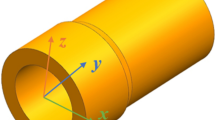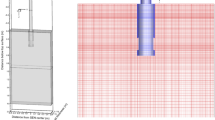Abstract
In this paper, the physical simulation of filling process of vertical centrifugal casting (VCC) of complex titanium alloy casting was studied. Combined with the mature PTV particle tracking technology, the high-speed photography pictures of the filling process of VCC at different rotational speeds were obtained. The trajectory and velocity information of tracer particles in the rotating flow field were obtained by the corresponding analysis software. Then, through the analysis and modeling of quantitative experimental data, the flow behavior characteristics and movement law of titanium alloy melt in the mold cavity under different mold speeds were studied. The results show that: 1. When the mold is still, the front edge of the filling fluid forms a curved surface with the curvature center pointing to the outside of the mold; when the mold rotates, the front edge of the liquid flow forms a curved surface with the curvature center pointing to the inside of the mold; 2. With the increase of the mold rotation speed, the speed of the fluid filling the mold increases significantly; when the rotational speed is greater than 120 rpm, the fluid still has a certain driving force in the mold center far away from the gate; it is good for filling the inner corner of mold with fluid; and 3. When the rotational speed of centrifugal casting of titanium alloy reaches 45 rpm or above, typical turbulent vortices appear in the wake; with the increase of rotating speed to 180 rpm, the average curvature radius of turbulent vortices first increases and then decreases, and reaches the minimum value of 0.67 cm at 120 rpm.
















Similar content being viewed by others
Data availability
The data that support the findings of this study are available from the corresponding authors, upon reasonable request.
References
Jiang H, Zhang X (2017) Research and application status of titanium alloy at home and abroad. Adv Mater Ind 3:7–10. (In Chinese)
Chirita G, Soares D, Silva FS (2008) Advantages of the centrifugal casting technique for the production of structural components with Al–Si alloys. Mater Des 29(1):20–27
Liu B, Huang T et al (2009) Foundry forming manual[M]. Beijing: Chemical Industry Press, pp 277–313. (In Chinese)
Jia L, Liang Z, Xu D et al (2016) Effects of centrifugal forces and casting modulus on structures and mechanical properties of Ti-6Al-4V alloy. Rare Metal Mater Eng 45(3):581–587
Prasad KSK, Murali MS, Mukunda PG (2010) Analysis of fluid flow in centrifugal casting. Front Mater Sci Chin 4(1):103–110
Shailesh Rao A, Tattimani MS, Rao S (2015) Effect of rotational speeds on the cast tube during vertical centrifugal casting process on appearance, microstructure, and hardness behavior for Al-2Si alloy. Metall Mater Trans B 46(2):793–799
Wang K, Sun W, Li B et al (2011) Microstructures in centrifugal casting of SiCp/AlSi9Mg composites with different mould rotation speeds. J Wuhan Univ Technol Mater Sci 26(3):504–509
Hu Y, Shao J, Chen G (2008) Comparative study of several PTV algorithms. Proceedings of the 21st national symposium on hydrodynamics and the 8th national symposium on hydrodynamics and the symposium on ship and ocean engineering hydrodynamics. (In Chinese)
Wu S, Zhang J, Xu Q et al (2008) Numerical simulation of mold filling and solidification process in centrifugal casting. Foundry Equipment & Technology 6:25–27. (In Chinese)
Wu S, Guo J, Zhang J et al (2011) The research progress of precision forming theory and technology of titanium alloy casting. Materials China 07:16–23. (In Chinese)
Changyun L, Shiping W, Jingjie G et al (2006) Hydraulic modelling of mould filling behaviour during vertical centrifugal casting processing. Int J Cast Met Res 19(4):237–240
Ren MX, Wang GT, Li BS et al (2014) Similar physical simulation of microflow in micro-channel by centrifugal casting process. Trans Nonferrous Metals Soc China 24(4):1094–1100
Zhou N (2014) Engineering fluid mechanics. Beijing: China Machine Press, pp 195–209. (In Chinese)
Alberini F, Liu L, Stitt EH et al (2017) Comparison between 3-D-PTV and 2-D-PIV for determination of hydrodynamics of complex fluids in a stirred vessel. Chem Eng Sci 171:189–203
Alvarez Chavez JA, Offerhaus HL, Sierra-Calderon A, Plascencia-Barrera G (2018) In-house PIV laser system design and development for measuring the velocity of liquids. Abstract from XVI symposium of Mexican students and studies in the UK 2018, Southampton, United Kingdom. https://doi.org/10.5281/zenodo.1421958
Estrada-Perez CE, Hassan YA (2010) PTV experiments of subcooled boiling flow through a vertical rectangular channel. Int J Multiph Flow 36(9):691–706
Hagemeier T, Bück A, Tsotsas E (2015) Estimation of particle rotation in fluidized beds by means of PTV. Procedia Eng 102:841–849
Murai Y, Vlaskamp JHA, Nambu Y et al (2013) Off-axis PTV for 3-D visualization of rotating columnar flows. Exp Thermal Fluid Sci 51:342–353
Jiang Z, Hagemeier T, Bück A, Tsotsas E (2018) Color-PTV measurement and CFD-DEM simulation of the dynamics of poly-disperse particle systems in a pseudo-2D fluidized bed. Chem Eng Sci 179:115–132
Funding
This work is supported by National Key R&D Program 2020YFB1710100. The authors would also like to acknowledge financial support from the National Natural Science Foundation Council of China (Grant No. 51605174, No. 51775205, No. 51905188).
Author information
Authors and Affiliations
Contributions
All authors developed the theory and performed the computations. Also, all authors discussed the results and contributed to the final manuscript.
Corresponding author
Ethics declarations
Ethics approval
For this type of study, formal consent is not required.
Consent to participate
The authors voluntarily agreed to participate in this research study.
Consent for publication
The author transfers to Springer the non-exclusive publication rights and he warrants that his/her contribution is original and that he/she has full power to make this grant. The author signs for and accepts responsibility for releasing this material on behalf of all co-authors. This transfer of publication rights covers the non-exclusive right to reproduce and distribute the article, including reprints, translations, photographic reproductions, microform, electronic form (offline, online), or any other reproductions of similar nature. The author may self-archive an author-created version of his article on his own website and his institution’s repository, including his final version; however, he may not use Springer’s PDF version which is posted on www.springerlink.com. Furthermore, the author may only post his version provided acknowledgment is given to the journal and Springer as one of the original places of publication and a link is inserted to the published article on Springer’s website.
Competing interests
The authors declare no competing interests.
Additional information
Publisher's Note
Springer Nature remains neutral with regard to jurisdictional claims in published maps and institutional affiliations.
Rights and permissions
About this article
Cite this article
Yin, Y., Peng, X., Xiao, G. et al. Experiment on fluid regime under different rotate velocity in physical simulation of titanium vertical centrifugal casting. Int J Adv Manuf Technol 120, 583–597 (2022). https://doi.org/10.1007/s00170-021-08516-y
Received:
Accepted:
Published:
Issue Date:
DOI: https://doi.org/10.1007/s00170-021-08516-y




